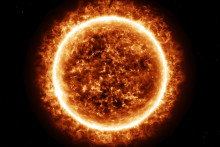nuclear fusion
A week ago, scientists at the National Ignition Facility at the Lawrence Livermore National Laboratory in California successfully produced a nuclear fusion reaction resulting in a net energy gain. The news quickly made headlines across the globe, being called ‘one of the most impressive scientific feats of the 21st century’, as many hope that nuclear fusion could one day provide clean energy for the world.
Arend Nijhuis is a researcher at the Energy, Materials & Systems (EMS) group, which focuses on sustainable energy, with the ambition of developing technologies, materials and systems that play a key role in our future energy chains. The EMS group is highly involved in state-of-the-art development of high current fusion conductors in large EU, USA and Chinese fusion projects. Nijhuis has worked on research projects directly related to nuclear fusion. For example, he led a UT team working on superconducting cables designed for the ITER fusion reactor.
Can you briefly explain what is nuclear fusion and why it’s important?
Nijhuis: ‘Nuclear fusion generates energy by fusing atomic nuclei, the same process that takes place on the Sun and other stars. This is an extremely powerful and attractive source of energy, but complex to realize as such on Earth. The nuclei of deuterium and tritium nuclei must be brought close together and must overcome the strong repelling force of their electrically positive charges. Starting a nuclear fusion reaction requires extreme heat, alike occurring on the Sun.
'Nuclear fusion does not produce long-term radioactive waste'
Once succeeding to control the reaction on the scale of a power plant, it would be a definitive breakthrough for the energy transition. Nuclear fusion is an energy source that, like nuclear fission, does not involve the emission of CO2, but is much safer because it cannot get out of hand via a chain reaction. Another advantage is that nuclear fusion does not produce long-term radioactive waste. The fuel for the reactor can be found in water and is available for millions of years.’
Last week, US scientists successfully produced a nuclear fusion reaction resulting in a net energy gain. Do you agree that it is indeed a scientific breakthrough?
‘We express the efficiency of fusion experiments as Q, which is the ratio between the energy produced and the energy consumed. For this US experiment, Q was 1.5 and this is the first time fusion has produced more energy than it consumes. In that sense it is certainly a scientific breakthrough.
'I expect it to have a very positive effect on fusion research'
It is absolutely a great and important achievement. To demonstrate that the type of fusion being studied at the National Ignition Facility (NIF) is a viable way to produce energy, the efficiency needs to be increased by orders of magnitude. Nevertheless, this is very positive news, showing that fusion keeps progressing year by year. Although this result is still a long way from the actual energy gain needed for economical electricity production. A result like this is enormously stimulating, so I expect it to have a very positive effect on fusion research and its facilitating technology more in general, like high current superconductor research as performed in the EMS group at the UT.’
The hope is that nuclear fusion could eventually provide huge quantities of clean energy. Do you see this as a likely scenario? If so, what is the timeline for making it a reality?
‘The NIF facility was not designed for commercial fusion power and even the ITER reactor, which is currently being built in France, will not supply power to the grid. That task is reserved for the various DEMO reactors, the successors to ITER, which will be built from 2040 and will only be completed around 2055. Subsequently, the industry must take over to actually build power plants. The result: only around 2080 fusion will be able to provide a few tens of percent of our energy needs.
'We have seen massive increases in private investment for fusion companies'
However, the last decade we have seen massive increases in private investment for fusion companies around the world. They claim to have reactors that can supply power to the grid around 2030. Also, the enabling technologies and materials developments required to increase the economic efficiency of a reactor show exceptional progress. That in combination with the continued increase in private investment and increasing government support for fusion, makes it is increasingly likely that commercial fusion will become a reality within the next two decades.’
Is there any research on nuclear fusion done at the UT?
‘The Energy, Materials and Systems (EMS) group at the UT is closely involved in the research and development of superconductors for fusion magnets. High current superconductors are crucial for fusion reactors like ITER. No superconductors, no fusion with magnetic confinement. The ITER project is a collaboration between China, the European Union, India, Japan, Korea, Russia and the United States and costs more than 20 billion euros. The EMS group has played a key role in solving the problems with the superconductors at the start of the ITER project. The EMS group is strongly embedded in the international fusion field due to its long-time expertise on superconducting materials and applications and expansive international network.’







